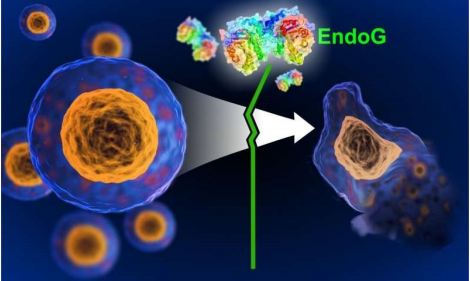RUDN Biochemists Discovered an Enzyme to Stop Cell Death

There are several enzymes called apoptotic endonucleases that participate in the programmed cell death. RUDN biochemists demonstrated that one of them named EndoG can stop the cell death process if it goes out of control. It turned out that increased EndoG secretion reduces the volumes of another endonuclease called DNase I and slows down the process of apoptosis on its early stage. Previously the two enzymes were supposed to work together, i.e. to mutually affect the DNA of a defective cell to destroy it. RUDN biochemists were the first to demonstrate that EndoG and DNase I were in fact more competitors than comrades.
“The EndoG enzyme acts as a protective mechanism against DNase I and DNA destruction. In this case the mechanism of cell death turns out to be very interesting: EndoG, the enzyme that destroys DNA, is able to stop apoptosis if it goes too far or too fast”, said Dmitry Zhdanov, a co-author of the work, a Candidate of Biology, and an Assistant Professor of Berezov Department of Biochemistry at RUDN.
To carry out the experimental research, RUDN biochemists used the blood of 50 people from 18 to 25 years of age without any diagnosed diseases. The scientists induced the increase of EndoG synthesis in Tlymphocytes of the donors. Then using a DNA-destroying substance called bleomycin the scientists initiated the process of apoptosis in the cells and measured the levels of EndoG and DNAse I. It turned out that the excess of EndoG reduced the level of DNAse I and therefore slowed down the whole process of apoptosis.
“We were the first to demonstrate the negative correlation between EndoG and DNAse I. This discovery may help fine-tune the response of a cell to any damage, and the activation of EndoG may become a protective mechanism against uncontrolled cell death”, added Zhdanov.
The participants of the study also represented Orekhovich Science and Training Institute for Biomedical Chemistry and Blokhin National Medical Research Center of Oncology.
Chemist from RUDN received a new structural type of compound that includes atoms of metals (copper and sodium) in the frame structure, in the form resembling a bicycle helmet. The compound exhibits catalytic activity in two important organic synthesis reactions. Development can be used in the context of creating new catalysts for the chemical industry. The work of scientists published in the journal Dalton Transaction.
RUDN mathematicians confirmed that the Earth has other satellites besides the Moon - cosmic dust clouds that are difficult to observe. A hypothesis about their existence had been developed 60 years ago, but first confirmations were obtained only last year. The calculations of RUDN mathematicians give a mathematical proof of the obtained data and will be used to plan space missions.
A team of agrochemists from Russia, Germany, and Chile confirmed the so-called ferrous wheel hypothesis - the turnover of iron in the soil that enriches it with organic nitrogen. The results of the study were published in the Geochimica at Cosmochimica Acta journal.
Chemist from RUDN received a new structural type of compound that includes atoms of metals (copper and sodium) in the frame structure, in the form resembling a bicycle helmet. The compound exhibits catalytic activity in two important organic synthesis reactions. Development can be used in the context of creating new catalysts for the chemical industry. The work of scientists published in the journal Dalton Transaction.
RUDN mathematicians confirmed that the Earth has other satellites besides the Moon - cosmic dust clouds that are difficult to observe. A hypothesis about their existence had been developed 60 years ago, but first confirmations were obtained only last year. The calculations of RUDN mathematicians give a mathematical proof of the obtained data and will be used to plan space missions.
A team of agrochemists from Russia, Germany, and Chile confirmed the so-called ferrous wheel hypothesis - the turnover of iron in the soil that enriches it with organic nitrogen. The results of the study were published in the Geochimica at Cosmochimica Acta journal.